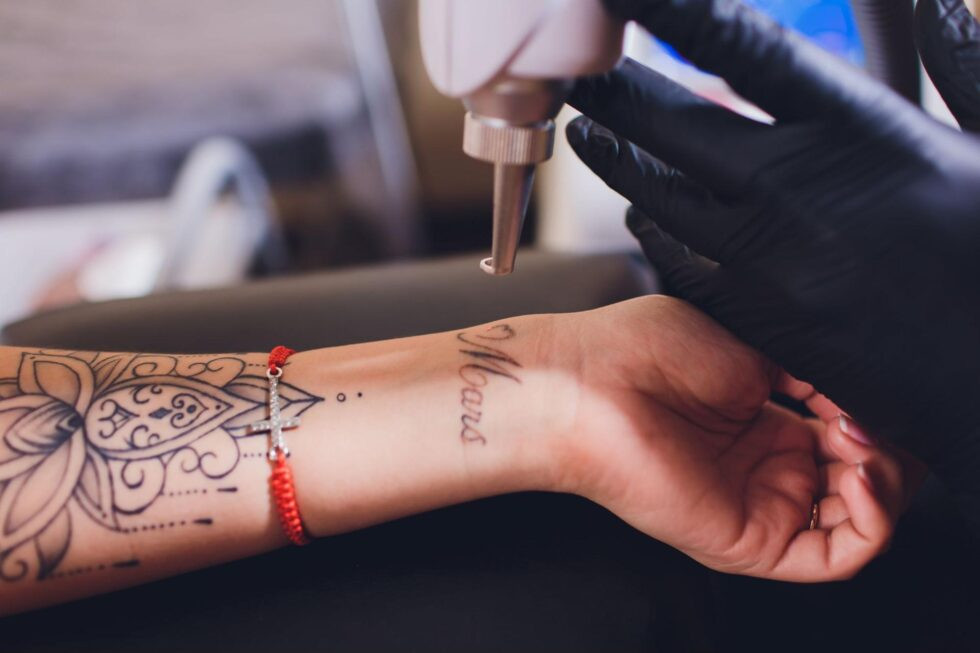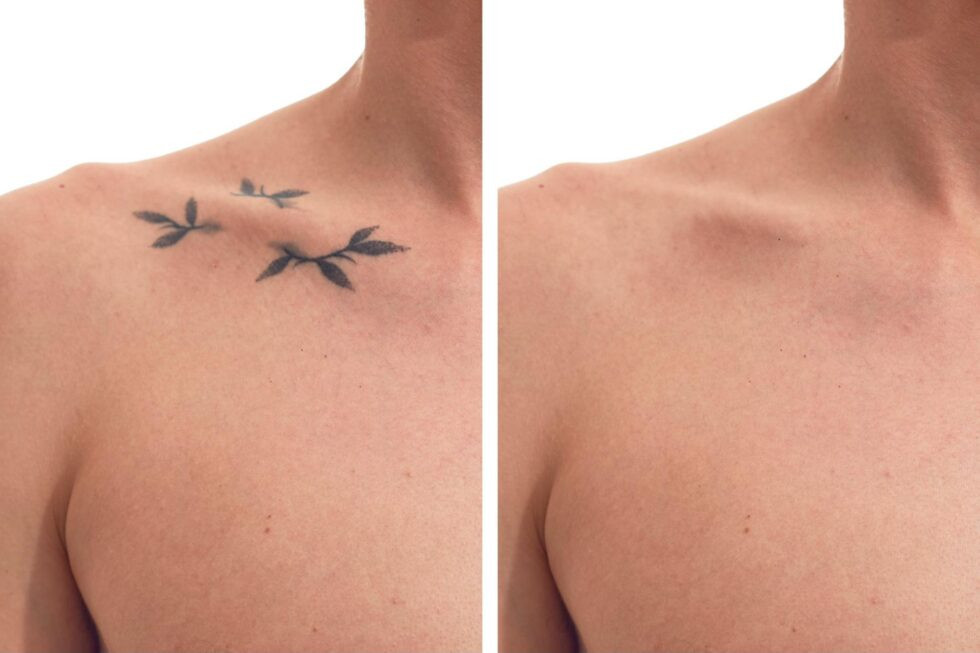Does Tattoo Removal Scar Your Skin? Absolutely not necessarily, with proper techniques and aftercare! At tattooat.com, we understand your concerns about potential scarring from tattoo removal, and we’re here to provide the ultimate guide to achieving the best possible outcome, revealing clear skin. Our comprehensive approach includes innovative laser technologies, expert advice on tattoo aftercare, and insights into minimizing the risk of skin damage. This article will explore the factors contributing to scarring, effective prevention methods, and advanced treatments to help you regain your skin’s natural beauty. Explore tattoo fading options and laser treatment methods with confidence!
1. What is Tattoo Removal and How Does It Work?
Tattoo removal involves breaking down the tattoo ink pigments beneath the skin to gradually fade or completely erase unwanted tattoos. The most effective method is laser tattoo removal, which uses advanced laser technology to shatter ink particles. These particles are then naturally eliminated by the body’s immune system over time.
The two primary lasers used in this process are:
- Q-Switched Lasers: One of the earliest and still effective laser technologies, Q-switched lasers emit short bursts of light energy that target ink particles without harming the surrounding skin. They are ideal for treating dermal pigmentation.
- Pico Lasers: Pico lasers represent newer, faster, and more efficient technology. They deliver light energy in picosecond intervals, breaking down ink into even smaller particles. Pico lasers excel at treating stubborn tattoos and a wider range of ink colors while potentially reducing the total number of treatment sessions.
 Laser tattoo removal in progress on the arm, using advanced laser technology for safe ink removal.
Laser tattoo removal in progress on the arm, using advanced laser technology for safe ink removal.
2. Can Tattoo Removal Cause Scarring? Understanding the Risks
Can tattoo removal cause scarring? While modern laser tattoo removal techniques are designed to minimize skin damage, the risk of scarring does exist, especially if proper precautions aren’t taken before, during, and after the procedure.
Several factors can contribute to scarring:
- Pre-existing Scars: Scars from the original tattoo application can sometimes be present. Poor healing or scabbing during the initial tattoo process can leave behind scars that laser treatments cannot fully remove, although they can improve the appearance.
- Excessive Heat from the Laser: Improper use of the laser can generate excessive heat, potentially damaging the skin and leading to thermal burns or scars. It’s crucial to choose a skilled and experienced dermatologist who understands how to adjust laser settings based on your skin type and tattoo characteristics.
- Inadequate Aftercare: Neglecting aftercare protocols is a major cause of scarring after tattoo removal. Without proper protection and hydration, the skin becomes vulnerable to infections, delayed healing, and the formation of keloid scars.
- Skin Type: Individuals with darker skin tones are more prone to hyperpigmentation (darkening of the skin) or hypopigmentation (lightening of the skin) after laser treatment.
3. What to Expect Regarding Scarring After Laser Tattoo Removal
Understanding the potential risks and following proper aftercare procedures can significantly reduce the likelihood of scarring. Here’s what you need to know to minimize the chance of scarring after laser tattoo removal:
3.1. Scarring Risks Are Generally Low
Generally, laser tattoo removal has a low risk of scarring when performed correctly. Advances in laser technology have minimized skin damage, making treatments safer and more effective. However, it’s important to remember that everyone’s skin reacts differently, so there is always a small chance of complications.
3.2. Aftercare is Critical for Preventing Scars
Proper aftercare following each laser session significantly impacts the healing process. Follow these steps to minimize scarring risk:
- Keep the Treated Area Clean: Gently clean the treated area with mild soap and water after each session to prevent infection.
- Moisturize Regularly: Keep the skin moisturized with a fragrance-free, hydrating ointment or cream. This promotes healing and reduces the chance of dry, cracked skin, which can lead to scarring.
- Avoid Picking or Scratching: As your skin heals, it may scab or peel slightly. Avoid picking or scratching the area, as this interferes with healing and increases scarring risk.
- Sun Protection is Essential: Laser treatments make your skin more sensitive to sunlight. Apply a broad-spectrum sunscreen with an SPF of 30 or higher to protect your skin from damage and prevent hyperpigmentation.
3.3. Pre-Existing Skin Conditions Matter
Those with a history of keloid scars or a predisposition to hyperpigmentation are at a higher risk of scarring. If you have sensitive skin or are prone to specific skin conditions, discuss this with your dermatologist before starting treatment.
3.4. Multiple Follow-Up Sessions Are Required
Tattoo removal is a process that typically requires multiple sessions to fully remove the ink. The number of sessions depends on the size, color, and age of the tattoo. Following the recommended treatment plan and avoiding rushing the process are crucial. Scheduling sessions too close together can irritate the skin and increase the risk of scarring.
3.5. Healing Times Can Differ
The time your skin takes to heal depends on several factors, including tattoo depth, colors used, and your skin’s overall health. Typically, the treated area needs several weeks to heal fully between sessions. During this time, monitor your skin for signs of irritation or infection, and contact your dermatologist if you notice any unusual symptoms.
4. Choosing the Right Tattoo Removal Method
Several methods exist for tattoo removal, but laser tattoo removal is widely considered the most effective and safest option. Other methods, such as surgical excision, dermabrasion, and chemical peels, can be more invasive and carry a higher risk of scarring.
5. Laser Tattoo Removal: A Detailed Look
Laser tattoo removal works by delivering concentrated pulses of light energy to the tattoo ink, breaking it into tiny particles that the body can eliminate. Different lasers target different ink colors, making it essential to choose the right laser for your tattoo.
5.1. Types of Lasers Used
- Q-Switched Lasers: Effective for darker ink colors like black and blue.
- Pico Lasers: Work faster and more efficiently than Q-switched lasers, breaking down ink into smaller particles. They can also treat a broader range of ink colors, including greens and reds.
5.2. Factors Affecting the Number of Sessions
Several factors determine the number of sessions required for complete tattoo removal:
- Tattoo Size: Larger tattoos require more sessions.
- Ink Color: Some ink colors are more challenging to remove.
- Ink Density: Tattoos with higher ink density require more sessions.
- Tattoo Age: Older tattoos tend to fade more easily.
- Skin Tone: Skin tone can affect laser settings and the number of treatments needed.
- Location of the Tattoo: Tattoos closer to the heart typically respond faster due to better circulation.
5.3. Potential Side Effects
While laser tattoo removal is generally safe, potential side effects include:
- Redness
- Swelling
- Blistering
- Scabbing
- Hyperpigmentation
- Hypopigmentation
These side effects are usually temporary and resolve with proper care.
6. How to Minimize Scarring After Tattoo Removal
While scarring is always a possibility, several steps can minimize the risk and promote smooth, healthy healing:
- Choose a Reputable Clinic: Ensure your tattoo removal is performed by an experienced professional using the latest laser technology. Clinics specializing in non-invasive procedures are more likely to deliver safe and effective results.
- Follow Aftercare Instructions: Adhere strictly to the aftercare instructions provided by your dermatologist. This includes keeping the area clean, moisturizing regularly, and protecting it from the sun.
- Use Scar-Reducing Products: Consider using scar-reducing creams or gels to help smooth the skin’s texture. Ingredients like silicone and vitamin E can help reduce the appearance of scars.
- Consider Skin Resurfacing Treatments: If mild scarring occurs, treatments such as laser skin resurfacing or chemical peels can improve the scar’s appearance by stimulating new collagen production.
 Clear skin after successful tattoo removal, with no visible ink or scarring.
Clear skin after successful tattoo removal, with no visible ink or scarring.
7. Tips for a Smooth Recovery
To promote a smooth recovery and minimize scarring, consider the following:
- Stay Hydrated: Drinking plenty of water helps keep your skin hydrated.
- Eat a Healthy Diet: A balanced diet rich in vitamins and minerals supports healing.
- Avoid Smoking: Smoking can impair blood flow and delay healing.
- Manage Stress: High stress levels can affect your immune system and healing process.
8. Advanced Techniques for Scar Treatment
If scarring does occur after tattoo removal, several advanced techniques can help improve its appearance:
- Laser Resurfacing: Lasers can help remodel collagen and improve the texture and appearance of scars.
- Microneedling: This procedure stimulates collagen production, reducing the appearance of scars.
- Chemical Peels: Chemical peels can remove damaged skin layers and promote new skin growth.
- Topical Treatments: Prescription creams and ointments can help reduce inflammation and improve scar appearance.
- Steroid Injections: Injections can reduce inflammation and flatten raised scars.
- Surgical Excision: In severe cases, surgical excision may be necessary to remove the scar.
9. Debunking Common Myths About Tattoo Removal
Many misconceptions surround tattoo removal. Let’s address some common myths:
- Myth: Tattoo removal is extremely painful.
- Fact: While some discomfort is involved, most people tolerate the procedure well. Numbing creams and cooling devices can minimize pain.
- Myth: Tattoo removal is quick and easy.
- Fact: Tattoo removal requires multiple sessions and patience. The process takes time and commitment.
- Myth: All tattoos can be completely removed.
- Fact: While most tattoos can be significantly faded or completely removed, some ink colors and types may be more resistant to treatment.
- Myth: Tattoo removal always leaves scars.
- Fact: With proper techniques and aftercare, the risk of scarring is low.
10. Frequently Asked Questions (FAQs) About Tattoo Removal and Scarring
Let’s address some common questions regarding tattoo removal and scarring:
1. Will tattoo removal completely erase my tattoo?
Answer: While complete removal is the goal, the success depends on factors like ink color, tattoo size, and your skin type. Multiple sessions are typically required to achieve the best possible results.
2. How painful is laser tattoo removal?
Answer: Most patients describe the sensation as similar to a rubber band snapping against the skin. Numbing creams and cooling devices can help minimize discomfort.
3. How many sessions will I need?
Answer: The number of sessions varies depending on the tattoo’s size, ink color, density, and your skin’s response to treatment. On average, most tattoos require between 5 and 10 sessions.
4. What is the best laser for tattoo removal?
Answer: Pico lasers are generally considered the most advanced and effective for tattoo removal due to their ability to break down ink into smaller particles, treating a wider range of ink colors.
5. Can I remove a tattoo at home?
Answer: Avoid DIY tattoo removal methods, as they are ineffective and can cause serious skin damage, leading to scarring and infection.
6. What should I do immediately after a laser tattoo removal session?
Answer: Apply a cold compress to reduce swelling, keep the area clean and dry, and follow all aftercare instructions provided by your dermatologist.
7. How long does it take for the skin to heal after each session?
Answer: The skin typically takes 2-4 weeks to heal fully between sessions.
8. Can I go in the sun after tattoo removal?
Answer: Avoid sun exposure and apply a broad-spectrum sunscreen to protect the treated area. Sun exposure can lead to hyperpigmentation and delay healing.
9. What if I develop a blister after laser tattoo removal?
Answer: Do not pop the blister. Keep it clean and covered with a sterile bandage. Contact your dermatologist for further instructions.
10. Can tattoo removal improve the appearance of pre-existing scars from the tattoo process?
Answer: Yes, laser treatments can improve the appearance of old scars by stimulating skin resurfacing and collagen production.
In conclusion, while the question “Does tattoo removal scar your skin?” is a valid concern, the risk is minimal with proper techniques, aftercare, and a reputable clinic. Modern laser technology has made tattoo removal safer and more effective than ever before. By understanding the factors contributing to scarring and following the guidelines outlined in this article, you can minimize risks and achieve clear, healthy skin.
Ready to begin your journey towards tattoo-free skin? At tattooat.com, we offer a wealth of resources to help you make informed decisions. Explore our extensive collection of tattoo designs, discover talented tattoo artists, and access comprehensive guides on tattoo aftercare.
Discover inspiration for your next tattoo, find the perfect artist to bring your vision to life, and learn how to care for your new ink. Whether you’re considering tattoo removal or looking to add to your collection, tattooat.com is your ultimate resource for all things tattoo-related.
Visit tattooat.com today and unlock a world of tattoo inspiration and knowledge!
Address: 1825 SW Broadway, Portland, OR 97201, United States
Phone: +1 (503) 725-3000
Website: tattooat.com
